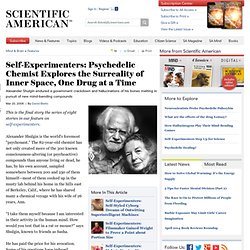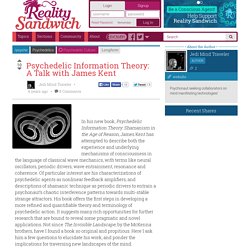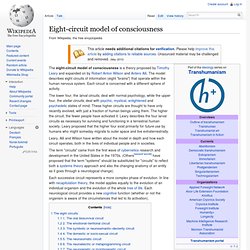

Self-Experimenters: Psychedelic Chemist Explores the Surreality of Inner Space, One Drug at a Time. This is the final story the series of eight stories in our feature on self-experimenters.

Alexander Shulgin is the world's foremost "psychonaut. " The 82-year-old chemist has not only created more of the 300 known consciousness-altering (or psychoactive) compounds than anyone living or dead, he has, by his own account, sampled somewhere between 200 and 250 of them himself—most of them cooked up in the musty lab behind his home in the hills east of Berkeley, Calif., where he has shared many a chemical voyage with his wife of 26 years, Ann. "I take them myself because I am interested in their activity in the human mind. How would you test that in a rat or mouse? " says Shulgin, known to friends as Sasha. He has paid the price for his avocation. As a student at the University of California, Berkeley, in the 1950s, Shulgin's gateway drug was mescaline, a naturally occurring psychedelic found in peyote and other groovy cacti.
Shulgin, who left Dow in 1965 to consult for the U.S. And Transformation. Zürich Center Psilocybin-Serotonin Receptor Research. A recent focus of the Heffter Zürich Research Center has been an examination of serotonin 5-HT2A neuroreceptor dynamics in the human brain following psilocybin, and its potential relevance for the treatment of obsessive-compulsive spectrum disorders (OCSDs), including OCD and eating disorders. The study is being carried out by Dr. Felix Hasler, Ph.D. and Boris B. Quednow, under the direction of Heffter board member Franz X. Vollenweider. Initial studies involved synthesizing the positron-emitting tracer molecule [18F]-altanserin, which binds to brain serotonin 5-HT2A receptors.
Reviews - Better living through chemistry (5 Jan 1998) Transcending the Medical Frontiers: Exploring the Future of Psychedelic Drug Research. When I was in graduate school studying behavioral neuroscience I wanted nothing more than to be able to conduct psychedelic drug research. However, in the mid-1980s, this was impossible to do at any academic institution on Earth. There wasn’t a single government on the entire planet that legally allowed clinical research with psychedelic drugs. However, this worldwide research ban started to recede in the early 1990s, and we’re currently witnessing a renaissance of medical research into psychedelic drugs. Working with the Multidisciplinary Association for Psychedelic Studies (MAPS) for the past four years as their guest editor has been an extremely exciting and tremendously fruitful endeavor for me.
It’s a great joy to see how MDMA can help people suffering from posttraumatic stress disorder (PTSD), how LSD can help advanced-stage cancer patients come to peace with the dying process, and how ibogaine can help opiate addicts overcome their addiction. ESP & Psychic Phenomena. Psychedelic Information Theory: Home Page. Psychedelic Information Theory: A Talk with James Kent. In his new book, Psychedelic Information Theory: Shamanism in the Age of Reason, James Kent has attempted to describe both the experience and underlying mechanisms of consciousness in the language of classical wave mechanics, with terms like neural oscillators, periodic drivers, wave entrainment, resonance and coherence.

Of particular interest are his characterizations of psychedelic agents as nonlinear feedback amplifiers, and descriptions of shamanic technique as periodic drivers to entrain a psychonaut’s chaotic interference patterns towards multi-stable strange attractors. His book offers the first steps in developing a more refined and quantifiable theory and terminology of psychedelic action. It suggests many rich opportunities for further research that are bound to reveal some pragmatic and novel applications. Not since The Invisible Landscape, by the McKenna brothers, have I found a book so original and propitious. Psychedelic drug cuts brain blood flow and connections - health - 08 April 2011. Psychedelic drug users throughout the ages have described their experiences as mind-expanding.

They might be surprised, therefore, to hear that psilocybin – the active ingredient in magic mushrooms – actually decreases blood flow as well as connectivity between important areas of the brain that control perception and cognition. The same areas can be overactive in people who suffer from depression, making the drug a potential treatment option for the condition. The study is the first time that psilocybin's effects have been measured with fMRI, and the first experiment involving a hallucinogenic drug and human participants in the UK for decades. Robin Carhart-Harris at Imperial College London and colleagues recruited 30 volunteers who agreed to be injected with psilocybin and have their brain scanned using two types of fMRI.
Low flow. Psychedelic Medicine News - reliable information on psychedelics improving human health. LSD - The Problem-Solving Psychedelic. Eight-circuit model of consciousness. The eight-circuit model of consciousness is a theory proposed by Timothy Leary and expanded on by Robert Anton Wilson and Antero Alli.

The model describes eight circuits of information (eight "brains") that operate within the human nervous system. Each circuit is concerned with a different sphere of activity. Leary, Alli and Wilson have written about the model in depth and how each circuit operates, both in the lives of individual people and in societies. The term "circuits" came from the first wave of cybernetics research and development in the United States in the 1970s. (Others[weasel words] have proposed that the term "systems" should be substituted for "circuits" to reflect both a systems theory approach and also the changing anatomy of an entity as it goes through a neurological change).
The eight circuits[edit] 1. This circuit is concerned with nourishment, physical safety, comfort and survival, suckling, cuddling etc. A positive imprint sets up a basic attitude of trust. 2. 3. 4.